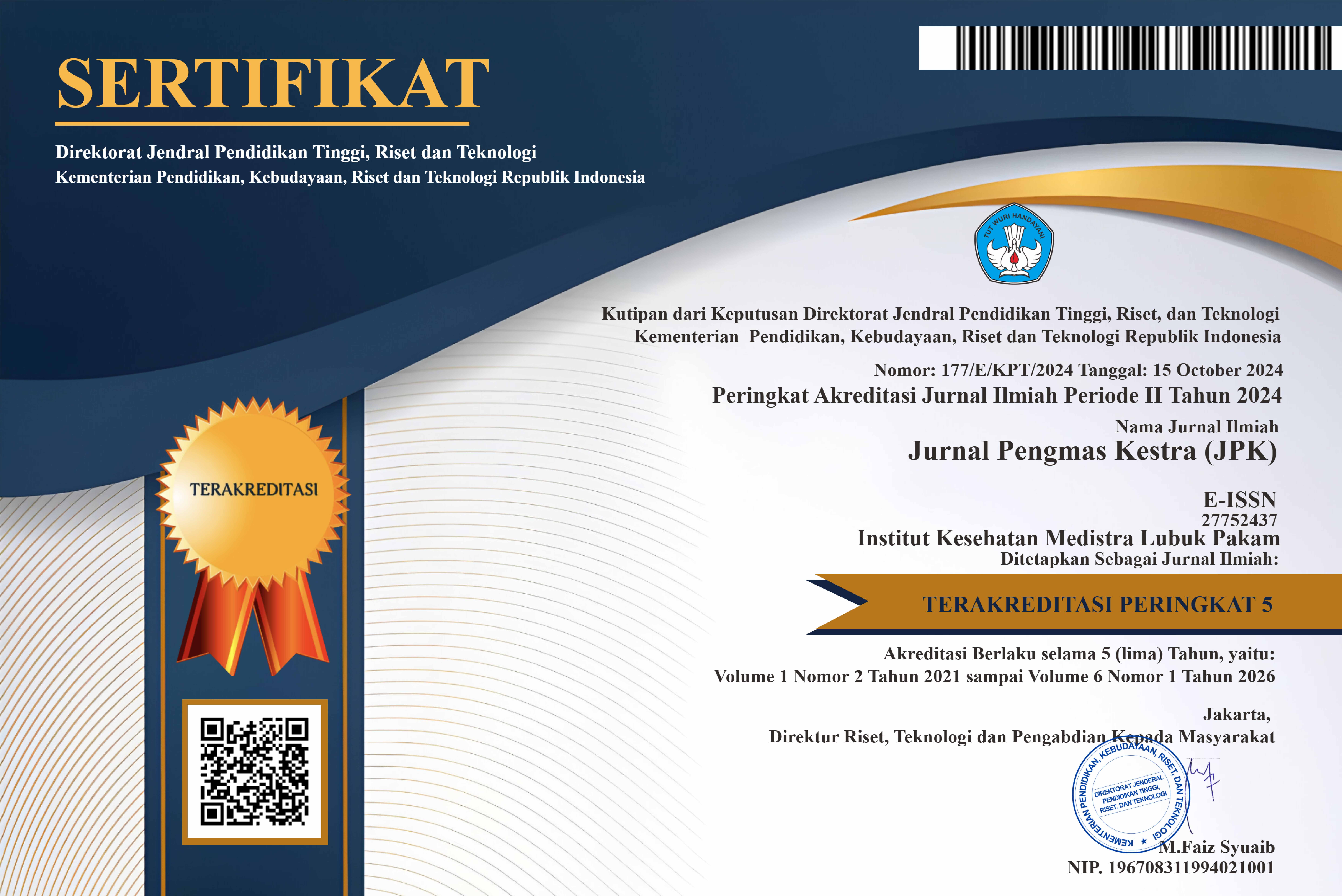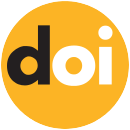Counseling on Insulin Injection Timing Management for Type II Diabetes Mellitus Patients at Grandmed Hospital Lubuk Pakam
DOI:
https://doi.org/10.35451/31fkt087Keywords:
Management, Type 2 Diabetes Patients, Education, Timing of Insulin InjectionAbstract
Type II Diabetes Mellitus (DM) is a chronic condition whose prevalence continues to rise in Indonesia. Although insulin therapy is commonly administered to patients, their knowledgeparticularly regarding the appropriate timing of insulin injection remains relatively low. This limited understanding may contribute to unstable blood glucose levels, highlighting the need for personalized management strategies, especially in the scheduling of insulin administration. This community engagement program was implemented through health education and counseling methods aimed at promoting a more proactive and preventive approach in the management of Type II DM. The educational strategy adopted was both informative and interactive, designed to enhance the comprehension of 18 outpatient participants diagnosed with Type II DM. The findings demonstrated that participants showed strong enthusiasm throughout the intervention, driven by a recognized need to better understand insulin injection timing and postprandial glucose control. Moreover, there was a measurable improvement in knowledge, with an average increase of 27.7 points from pre-test to post-test assessments. This outcome affirms the effectiveness of the health education activity in achieving the intended objectives of the program. Participants also expressed interest in the continuation of similar educational efforts in the future. Additionally, the distribution of educational materials in the form of leaflets containing guidance on insulin injection schedules, meal timing, and adherence to effective insulin therapy protocols served as a practical tool for application at home. In conclusion, this educational initiative successfully enhanced patient health literacy and provided effective guidance to support diabetes self-management. Furthermore, the activity contributed to improving the overall quality of life for patients by supporting better glycemic control and preventing long-term complications.
References
[1] Wijayakusuma, R., & Soedono, A. R. (2024). Program Studi Profesi Ners Program Profesi Universitas Kusuma Husada Surakarta Penerapan Terapi Relaksasi Otot Progresif Terhadap Penurunan Kadar Gula Darah Pasien Diabetes Melitus Tipe II. 1–8.
[2] Fitriani, Y., Pristianty, L., & Hermansyah, A. (2019). Pendekatan Health Belief Model ( HBM ) untuk Menganalisis Kepatuhan Pasien Diabetes Melitus Tipe 2 dalam Menggunakan Insulin Adopting Health Belief Model Theory to Analyze the Compliance of Type 2 Diabetes Mellitus Patient When Using Insulin Injection. 16(02), 167–177.
[3] Atika, R., Masruhim, M. A., & Fitriani, V. Y. (2016). Karakteristik Penggunaan Insulin Pada Pasien Diabetes Mellitus Tipe Ii Dengan Gangguan Ginjal Di Instalasi Rawat Inap Rsud a.W. Sjahranie Samarinda. April, 98–108. https://doi.org/10.25026/mpc.v3i1.72
[4] Kementerian Kesehatan RI, Riset Kesehatan Dasar (Riskesdas) 2018 – Pengendalian Penyakit Tidak Menular, Jakarta: Kemenkes RI, 2018. [Online]. Tersedia: https://www.kemkes.go.id/.
[5] American Diabetes Association, Standards of Medical Care in Diabetes – 2020, Diabetes Care, vol. 43, Suppl. 1, 2020. DOI: 10.2337/dc20-S001.
[6] L. A. Putri, T. Nugraha, dan A. Santoso, "Perbandingan efektivitas waktu injeksi insulin 15–30 menit sebelum makan terhadap penurunan glukosa postprandial pada pasien diabetes tipe II", J. Endokrinologi Klinik, vol. 12, no. 2, hlm. 89–97, 2021. [Online].
[7] Azis, W. A., Muriman, L. Y., & Burhan, S. R. (2020). Hubungan Tingkat Pengetahuan dengan Gaya Hidup Penderita Diabetes Mellitus. Jurnal Penelitian Perawat Profesional, 2(1), 105–114. https://doi.org/10.37287/jppp.v2i1.52
[8] D. Rahmawati dan P. Sari, "Dampak edukasi manajemen insulin terhadap kepatuhan pengobatan Diabetes Melitus tipe II di Puskesmas Sleman", J. Kesehat. Masy. DIY, vol. 7, no. 3, hlm. 120–127, 2019. [Online].
[9] R. Anwar dan S. Susanti, "Pengaruh edukasi terstruktur terhadap kontrol glikemik pada pasien Diabetes Melitus tipe II dalam jangka waktu 3 bulan", J. Keperawatan Komunitas, vol. 8, no. 1, hlm. 45–53, 2022. [Online].
[10] Kurniawati, T., Huriah, T., & Primanda, Y. (2019). Pengaruh diabetes self management education (DSME) terhadap self management pada pasien diabetes melitus. Jurnal Ilmiah Kesehatan, XII(II), 588–594.
[11] [D. M. N. Ratri, K. F. Hamidah, A. D. Puspitasari, dan M. Farid, “Video‑based health education to support insulin therapy in diabetes mellitus patients,” J. Public Health Res., vol. 9, no. 2, pp. 1849, 2020, doi:10.4081/jphr.2020.1849.
[12] I. R. Narahaubun, D. Handayani, dan H. Kristianto, “Insulin injection rotation and diabetes mellitus nutritional management education,” in 4th Int. Nursing and Health Sci. Symp., vol. 12, suppl. 1, 2024, doi:10.4081/hls.2024.13065.
[13] C. Riangkam, S. Ruksakulpiwat, P. Jariyasakulwong, V. Panichpathom, dan L. Phianhasin, “Educational interventions for individuals with insulin‑treated type 2 diabetes mellitus: A systematic review,” Patient Prefer. Adherence, vol. 18, pp. 1831–1843, Sept. 2024, doi:10.2147/PPA.S482882.
[14] H. Semi, S. M. Ahmad, M. Tuti, dan A. M. Islam, “Effectiveness of insulin injection technique on glycemic control of fasting plasma glucose and HbA1c in Type II DM patients at Hasanuddin University Hospital: Randomized Controlled Trial,” Indones. Contemp. Nurs. J. (ICON J.), vol. 9, no. 2, pp. 134–143, 2025, doi:10.20956/icon.v9i2.42527.
[15] W. S. Shiferaw, T. Y. Akalu, M. Desta, A. M. Kassie, P. M. Petrucka, dan Y. A. Aynalem, “Effect of educational interventions on knowledge of the disease and glycaemic control in patients with type 2 diabetes mellitus: a systematic review and meta‑analysis of randomized controlled trials,” BMJ Open, vol. 11, no. 12, e049806, 2021, doi:10.1136/bmjopen-2021-049806.
Downloads
Published
Issue
Section
License
Copyright (c) 2025 Pitriani Pitriani, Kardina Hayati, Abdi Lestari Sitepu

This work is licensed under a Creative Commons Attribution 4.0 International License.
Copyright in each article is the property of the Author.




















